Important disclaimer: In light of new information, this post needs to be taken with a really whoppin’ huge grain of salt. It turns out Tuoli was “feasting” on the day the survey crew came for China Study I, so they were likely eating more calories, more wheat, more dairy, and so forth than they typically do the rest of the year. We can’t be completely sure what their normal diet did look at the time, but the questionnaire data (which is supposedly more reliable than the diet survey data) still suggests they were eating a lot of animal products and very little in the way of fruits or vegetables.
At any rate, I recommend not quoting this post or citing it as “evidence” for anything simply because of the uncertainty surrounding the Tuoli data in the China Study. Please see the following posts for more information on the issue of Tuoli’s accuracy:
http://rawfoodsos.com/2010/08/03/the-china-study-a-formal-analysis-and-response/
http://rawfoodsos.com/2010/07/16/the-china-study-my-response-to-campbell/
As I mentioned in the previous post on dairy consumption and disease in China, there’s a fascinating little county by the name of “Tuoli” situated in northwest China—a place quite worthy of nutritional study, due to their unique diet.
They live here:
Which looks like this:
Where they eat a lot of this:
But not a lot of this:
The Tuoli diet is so abnormal for China, in fact, that T. Colin Campbell et al omitted this county from analysis in several China Study papers—such as “Vitamin A and cartenoid status in rural China,” published in the British Journal of Nutrition:
One county (Tuoli County in Xinjiang Autonomous Region), composed primarily of an ethnic minority population of herdspeople, had disproportionately high values for retinol, lipid and protein intake due to an exceptionally high intake of animal foods. This ‘outlier’ was not included in the analysis, to characterize more accurately the average intakes of the rural Chinese population and to avoid the undue influence of one data point on the results.
Given the prevailing beliefs about nutrition and health—such as saturated fat and cholesterol as a cause of heart disease, the necessity of fiber for colon health, the immunity-boosting properties of fruits and vegetables, and the dangers of a diet high in animal fat—it would seem the Tuoli should showcase the health woes that come from breaking every rule in the diet book.
But is that the case?
Tuoli diet
First, let’s take a closer look at what he China Project data has to say about these Tuoli folks.
In terms of macronutrients, the Tuoli consumed an average of 185.6 grams of fat, 172.5 grams of protein, and 322 grams of carbohydrates per day. Average energy intake was a whoppin’ 3704 calories, and average fiber intake was 17.9 grams per day—only slightly more than your run-of-the-mill American.
The average diet of all counties studied in the China Project is clearly carb-based, low in fat and protein (as a percent of total calories):
In contrast, the Tuoli diet is nearly half fat:
Main items on the Tuoli menu included:
- Dairy: 856.5 grams per day (almost two pounds)
- Wheat flour: 371.6 grams per day (0.82 pounds)
- Meat: 121 grams per day (a bit over a quarter of a pound)
Sparse and non-existent items included:
- Potatoes: five to six times per year
- Green vegetables: twice per year
- Fruit: less than once per year
- Legumes: never
- Sea vegetables: never
- Nuts: never
- Eggs: never
- Fish: never
- Plant oils (rapeseed, soybean, sesame, corn): never
- Soy sauce: never
Basically, these folks live on dairy, meat, and wheat, and refuse to eat their vegetables. Sounds like some Americans I know.
Tuoli blood markers and diseases
If the Tuoli’s meat-and-dairy-heavy diet is the source of disease, we’d expect to see these folks facing more chronic conditions than the regions eating plant-based diets. To test whether this is the case, let’s compare Tuoli with the 13 counties in the China Project that consumed less than 1 gram of animal protein per day—the closest thing we have to Chinese vegans.
I’ll be putting these all in a bar graphs, but to prevent an uber-cluttered x-axis, I’ll just use numbers corresponding to each county:
- Cixian
- Jingxing
- Huguan
- Jiangxian
- Jiexiu
- Linxian
- Songxian
- Jianhu
- Taixing
- Qingzhen
- Cangxi
- Shanyang
- Longxian
- Tuoli
The first 13 counties will always be blue bars; Tuoli will always be red.
Before getting to the mortality statistics, let’s look at some basic blood markers for heart disease. Here we have total cholesterol of the above counties, lined up side-by-side for comparison.
As you might expect, Tuolians* have higher total cholesterol than most of the near-vegan counties, although it’s still a healthy number by American standards. However, the difference between a couple of those counties isn’t all that profound: Tuoli’s cholesterol is tied with that of Shanyang and lags a bit behind Taixing, both of which consume only trivial amounts of animal products. Curious, indeed. Obviously, something other than animal product consumption affects blood cholesterol.
*”Tuolian” may or may not be an actual term.
Next, let’s peek at triglycerides—a type of blood fat that, in high amounts, can raise your risk of heart disease.
It seems Tuoli is pretty much neck-and-neck with the plant-eating counties. By American standards, triglyceride levels between 150 and 199 are considered borderline high, and lower numbers are considered normal—so only one county, a near-vegan one, had values outside a healthy range.
Disease rates
First up: Death from all causes (per 1000 people under the age of 65). Remember, Tuoli county is the red bar; the blue bars represent the near-vegan counties in the China Project that consumed less than 1 gram of animal protein per day on average.
Okay, so the Tuoli don’t have a higher death rate than the near-vegans. In fact, Tuoli’s total mortality rate is lower than 11 of the other counties and higher than only two.
But what about cancer? Let’s look at mortality from all cancers for Tuoli and the plant-lovin’ regions. Again, Tuoli is the red bar, and the near-vegan counties are the blue ones.
How ’bout them apples? Tuoli doesn’t appear to have higher cancer rates than the near-vegan areas. Eight counties have higher rates and only five have lower ones, leaving Tuoli hovering near the lower-middle end of the spectrum.
Next we have mortality from myocardial infarction (heart attacks) and coronary heart disease, per 1000 people. Tuoli is red, near-vegan counties are blue… you know the drill.
Surprised? Despite a massive intake of cholesterol, saturated fat, calories, animal protein, and all those other horrors ascribed to declining heart health, the Tuoli have relatively low levels of coronary heart disease and heart attacks. Seven near-vegan counties have higher rates than Tuoli, and six have lower rates.
And now for stroke mortality (per 1000 people).
Again, no significantly higher stroke rates for the Tuolians. Seven near-vegan counties have more incidences of stroke, and six have fewer incidences of stroke.
And since lack of fiber is supposed to harm colon health, here is a comparison of colon cancer and rectal cancer mortality (per 1000 people) between the plant-noshing counties and the vegetable-phobic Tuolians.
Looks like they’re doing pretty dandy without much fiber, right?
But what about leukemia? Let’s check it out:
As you can see, Tuoli isn’t significantly worse off than the near-vegan counties in terms of chronic disease. Total mortality rate is lower, cancer rates are lower or similar, heart attacks aren’t more common than usual, stroke rates are average. From this data alone, we’d have no basis for claiming that eating two pounds of dairy per day (and minimal vegetation, aside from wheat flour) is less healthful than consuming a mostly vegetarian diet. For sure, this data fails to support Campbell’s claim that chronic disease rates climb when animal protein intake rises.
(And as you’ll see in an upcoming post, it’s pretty surprising that the Tuoli had low rates of cardiovascular disease while eating high levels of wheat—but we’ll get to that later.)
Why aren’t these people sick and diseased?
We have plenty of evidence showing hormone-pumped dairy, grain-fed meat, pasteurized and homogenized milk, processed lunch meats, and other monstrosities are bad for the human body. No debate there. But we do have a woeful lack of research on the effects of “clean” animal products—meat from wild or pastured animals fed good diets, milk that hasn’t been heat-zapped, antibiotic-free cheeses and yogurts, and so forth. Perhaps the best data we have is from observational studies of isolated or primitive peoples (such as those studied by Weston A. Price), but those lack detailed documentation about mortality rates and don’t usually meet standards of scientific rigor.
In other words, this is one area where nutritional research is pretty deficient.
Is it possible the diseases we ascribe to animal products aren’t caused by animal products themselves, but by the chemicals, hormones, and treatment processes we expose them to? If the Tuoli are any indication, this may be the case. Hopefully future research will shed more light on the matter.
| 185.6 |
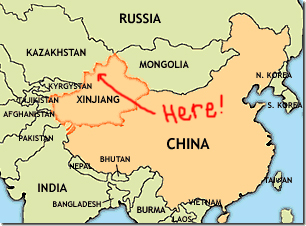
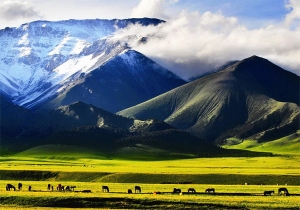
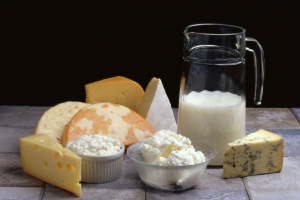
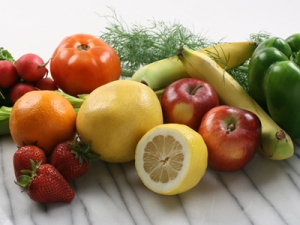
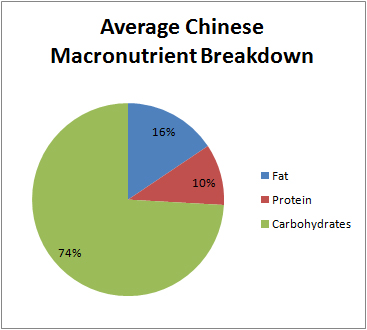
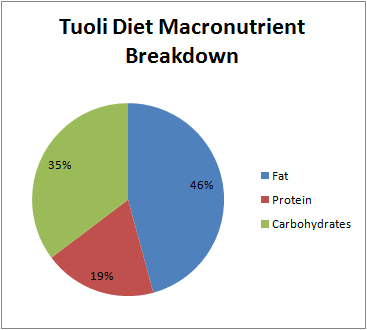
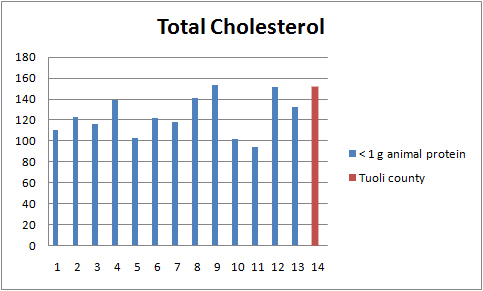
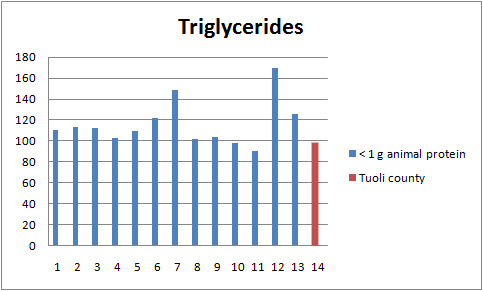
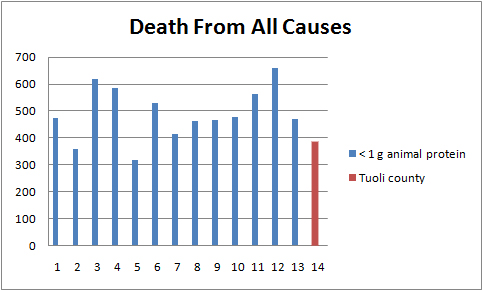
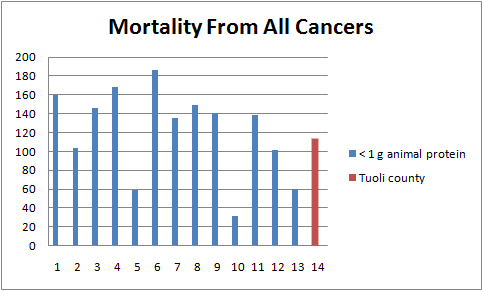
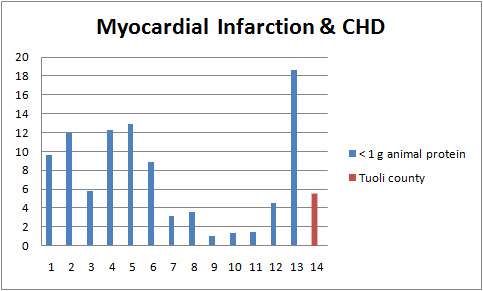
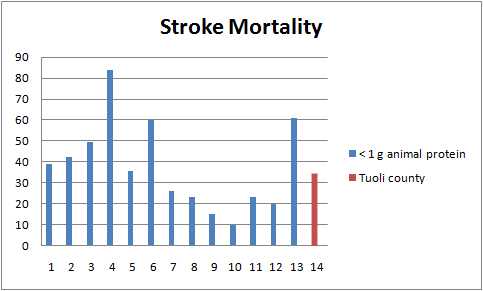
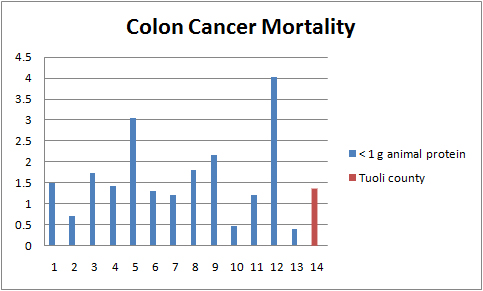
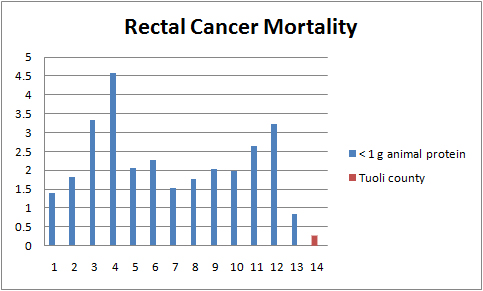
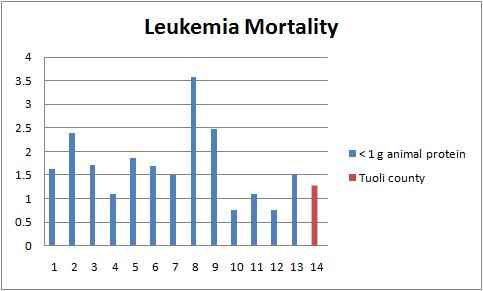
Thanks for writing, I’m enjoying the blog. You’ve made some great observations (intestinal length, wild vs. farmed) that really resonate with me as I work on improving my own diet. Cheers!
Cogent and concise, as usual. I often wonder though, if the conclusions reached by looking at statistics alone, could be somewhat misleading. In other words, it’s not so much that the Tuolians ( I like it even it’s a made up word) eat dairy/meat etc. but that they eat what’s native to their environment, that could be a contributing factor to good health or otherwise. They don’t eat veggies because it may not be possible to cultivate veggies in their environment and/or given their occupations as nomadic herdsmen. It’s interesting how so many nomadic pastoral tribes, in different parts of the world, seem to indulge in a surfeit of raw milk/fermented milk/blood etc. Which of course, doesn’t help when you live Stateside and everything is available all the time. Sigh! Some day we’ll have this diet thang figured out.
Great observations as usual! It would be interesting to compare the Tuolians (I like this word) with the Inuit tribes of Alaska. They too eat a lot of meat, but primarily from the ocean. I wonder what effect all the exercise they get from herding plays in this. They have to have a high caloric intake to maintain their active lifestyle. Maybe exercise plays a larger role in warding off disease than we think.
Excellent reviews, Denise!
I think YOU should write a book about the China Study too 🙂 No really. You should. This is extraordinary stuff.
After all this, I have to wonder. Why did Campbell write the book the way he did?
What do you think?
Great site. A lot of useful information here. I’m sending it to some friends!
The evidence is so strong that wheat is an inferior food, the Tuoli make a very good case for unprocessed dairy and meat. Even with all that wheat, the fact that they are still in good health is impressive.
…or perhaps their wheat is a local variety that Monsanto hasn’t been allowed to “improve”. o.O
If the Tuolians removed the pound-a-day wheat habit from their diets they would likely have the lowest markers in every single category. Great post.
That’s most likely the case
“We have plenty of evidence showing hormone-pumped dairy, grain-fed meat, pasteurized and homogenized milk, processed lunch meats, and other monstrosities are bad for the human body.”
Where, exactly, is the evidence that grain-fed meat is “bad” for the human body? The only so-called evidence I have ever ran across comes from poorly controlled (i.e failing to control variables, using low confidence levels so real results are even harder to distinguish from noise, etc) and poorly designed research papers.
Other than that, good post!
DML,
Grain fed cattle provide inferior meat. A grain diet changes the lipid profile of the animal whereby you have a poor balance between omega-3 and omerga-6 EFAs. Grass fed cattle are superior because they are healthier. An animal left to feed on its natural diet will always be healthier. What animal does well on grain? Certain bird species perhaps but I can’t really think of many others.
“Is it possible the diseases we ascribe to animal products aren’t caused by animal products themselves, but by the chemicals, hormones, and treatment processes we expose them to?”
You are jumping to conclusions. It is possible the diseases we ascribe to animal products are caused by refined sweeteners, polyunsaturated vegetable oils, and hydrogenated oils. You say that pasteurized homogenized milk is bad, but also say there’s no single optimal diet. Isn’t it possible that some people have adapted to pasteurized homogenized dairy and thrive on it, while failing to thrive on raw? It’s definitely possible. I’ve seen a lot of fat people drinking sodas, but I’ve also seen skinny people carrying 24-packs of Coke. People can adapt to anything. Primitive people would probably drop dead in a month if they ate the typical modern diet.
DML: “Where, exactly, is the evidence that grain-fed meat is “bad” for the human body? The only so-called evidence I have ever ran across comes from poorly controlled (i.e failing to control variables, using low confidence levels so real results are even harder to distinguish from noise, etc) and poorly designed research papers. ”
Where is the evidence that hormone-pumped milk, pasteurized homogenized milk, and processed lunch meats are “bad” for the human body? The only evidence I am aware of comes from poorly controlled studies (mostly epidemiology). It’s possible processed meats are to blame when meat is “associated” with some disease, but I would simply dismiss the whole thing. Correlation is not causality.
I’m curious as to what the Qingzhen people die of and what their average life span is?
Very good study. Someone should give you millions of dollars for follow research to extensively investigate this further.
I believe most deaths in this age range were from infectious disease throughout China. Still, you’re right, the levels of chronic disease are particularly low in Qingzhen.
“[M]eat consumption for one of the counties, Tuoli, was clearly not accurate on the 3 days that the data were being collected. On those days, they were essentially eating as if it were a feast to impress the survey team but on the question of frequency of consumption over the course of a year, it was very different.”
-Dr. Campbell (http://tynan.net/chinastudyresponse)
If the data was only collected for 3 days, how did they know and how did you know how many times a year a food was consumed?
The “frequency per year” data was from a questionnaire rather than from a food log, I believe.
Fascinating post Denise, thanks. A few points:
This diet is not unlike that of the former isolated Loetschental Valley inhabitants in Switzerland. One thing that bear in mind with isolated populations is that very likely have adaptations to their particular diet; these are genetic adaptations, which don’t take that long to evolve in a population:
http://healthcorrelator.blogspot.com/2010/01/how-long-does-it-take-for-food-related.html
This is a minor point, but the total cholesterol number is a bit low, and the triglycerides suggest a large-buoyant LDL particle pattern (see links below). I say this is a minor point because of the point made above – specific adaptations may make these comparisons worthless.
http://healthcorrelator.blogspot.com/2009/12/total-cholesterol-and-cardiovascular.html
http://healthcorrelator.blogspot.com/2010/04/low-fasting-triglycerides-marker-for.html
Finally, we need to look at the patterns of exercise of these folks, particularly glycogen-depleting exercise. Based on the caloric intake, I’d guess that they exercise heavily, causing severe glycogen depletion on a regular basis (this is generally good). With depleted glycogen stores, the carbs consumed do not lead to excessive triglyceride formation or fat deposition.
Having said that, I agree with you regarding the effect of modern processing on foods. It is generally a bad thing.
Excellent post ….
@Ned Koch. I don’t think the Tuoli exercised as much as you imply. They are muslim pastoralists that herd goats and weave rugs for a living. My wife is from Xinjiang, and she has many times described the minority group (now that the Han have overrun the place) that lives here. They are related to the Turks and other muslim groups in that part of Asia. I think the pastoralist lifestyle involves lots of sitting and slow walking (to move the herd around as they forage). It’s not the back-breaking, day-labor you see among the farmers. This should add some perspective and context to interpreting the Tuoli data. I do agree with you that microadaptation can happen very rapidly after dietary (or other environmental) shifts, as described in the book “The 10k year explosion.” So it is especially important to keep in mind that the Tuoli are a different ethnic group than the Han (i.e., they are mostly reproductively isolated for thousands of years).
Hi Aaron.
I think the calorie intake of the Tuoli might have been exaggerated. Campbell included this in his response to Denise’s post on the China Study. Denise highlighted this in her new post:
http://rawfoodsos.com/2010/07/16/the-china-study-my-response-to-campbell/
It seems that the Tuoli were “feasting” during the three-day diet survey, brining their calorie intake way higher than it would normally be.
Hi Ned,
Thanks for pointing that out. I don’t think the “calorie” hypothesis of weight set-point has much merit (I could be wrong, though), so I’m not sure that the average daily calorie intake is very meaningful unless you know where those calories are coming from. People have reported evidence that people can lose weight on high calorie diets that have few carbs, especially fructose, and mostly saturated fat rather than polyunsaturated fats, especially O6 heavy plant seed oils. While a low-cal diet that has a large portion coming from refined carbs (sugar, flour), industrial seed oils, and etc. can result in weight gain. I forget who’s quote this is, but I like the “You aren’t what you eat, you are what you do with what you eat.” I’ve come up with a similar saying for epigenetics: “You aren’t your genes, you are what you do with your genes.”
Btw, Denise, thank you so much for all of the hard and brilliant work you’ve put into deconstructing the China Study and the data on which it was based. That probably took more intellectual effort than my dissertation! You really should consider publishing your analysis in a top-tier peer-reviewed journal (if they let you). Kudos!
Nomadic herders, um no chance the fact these people probably burn 3000 to 4000 calories a day just to survive doesn’t have an effect? High fat high calorie diet while living a high impact high enery lifestyle versus citified populations eating a low energy diet with lots of oils, and salts; while smoking like chiminies? Also, what is the life expectancy in this population? Low cancer rates don’t mean much if they die in their 50s from falling off of horses.
“Is it possible the diseases we ascribe to animal products aren’t caused by animal products themselves, but by the chemicals, hormones, and treatment processes we expose them to?”
My guess: NO. I bet these people tend to get a lot of exercise in per day. I bet it is frequent and sustained excess energy consumption that hurts.
Hey, very interesting article, as usual!
I was just wondering, do you have more information about the region number 10? What region is is? What are their foods etc. Seems like it the lowest in almost everything…
Thanks
nevermind, I just saw you posted that… Can’t wait for your wheat report part 2!
Hi Denise,
I have been up in your neck of the woods…nice area. I know folks in Portland as well…maybe even in your circle. You are a beautiful woman with a gift for writing, but to be honest, I think you are acting in an immature way in how you are communicating your views around this topic. For the past 13 years, I have focused on and experimented with a whole foods – primary vegan diet. In that time, I have tried nearly every type of popularized vegan diet out there and even tried raw meat for a while. When I first started down the path of experimenting with the dietary effects on health and discovered the raw vegan diet, I was so excited I became religious about it. I had to tell nearly everyone I knew and felt an inner religious-like drive to do so. I also became somewhat arrogant, in how I defended my beliefs about nutrition. I have been around a while and know from attending health related workshops from coast to coast. I know that in many cases, a religious-like quality and arrogance pervade the raw food vegan movement, the Weston Price movement, and other dietary movements. The problem with being “religious” about health is it becomes very important to defend one’s beliefs…you feel as if you will lose a part of yourself if you are wrong. This is a dangerous place to be if you truly want to be scientific, objective, and help others with your teachings. When I read your site, I get a clear sense you are attacking Dr. Campbell…the spirit of your writing feels like “us vs. them”. I think it is great you are passionate about your diet and wish to share your knowledge with others and you are certainly entitled to your opinions. But if you communicate out of fear, (in order to be right) nobody wins. If you ask yourself: “what is my real motivation here?” …what is it? Certainly Dr. Campbell deserves better than to be made of butt of your humor on your website.
Well stated. Tone speaks volumes.
Wow, are you reading the same website? I believe she’s using humor to lighten up a topic that is visceral to most people, and to try to make the writing interesting (and I believe she succeeds). She’s even mentioned a number of times in different posts that she respects a lot of the anti-fat ‘gurus’ for their dedication to their work – she’s not trying to make fun of them.
What is her motivation here? To uncover the truth, and it’s pretty clear if you read the posts that a lot of ‘scientists’ have completely mislead the public based on unclear or blatantly false studies.
Denise,
\Not surprising to see that Campbell is silent on the topic of the data from Tuoli. Why does not talk about this region? We’ve seen this before in Ancel Key’s 7 Countries “Study” where he threw out all countries from which the data contradicted his hypothesis. This isn’t science, it is religion and religion has no place in science. Keep up the great work. You certainly seem to have TCC’s attention! ;o)
I read the “China Study” and felt that it was somewhat biased or skewed. Not much about methodology was included in the writing, and there seemed to be an inordinate amount of chest thumping during the discourse. The one aspect that was curious was the use of casein in feed for the rats and the conclusion that all animal proteins would behave similarly (too much of a stretch for me). Though we have tried and felt better on a raw vegan diet, the work of food preparation, and the limited choices while eating out made it difficult to continue. I felt very low energy even though we used supplements. Perhaps we did not give it enough time, but, I doubt that more time would have made any more difference. Now I am reading that hydrogenated vegetable oils may have more to do with cancer rates that proteins based on data that shows increased use of margarine and shortening correspond to increasing rates of heart disease and cancer. Science is can frustrating to follow when scientists approach with personal bias.
Hi Denise,
I should be able to figure this out myself, but I don’t know how to compare the rate of cardiovasular disease in the Tuoli with levels in the western world, e.g. United States. May I assume that the rate in Americans is significantly higher?
As the proud owner of Lamancha dairy goats I have a vested interest.
Thanks for your work — it’s greatly appreciated.
Dan,
Here is a site where you can find a graph showing rates per 1000 people in the US to compare with the data given above. And yes, the US is significantly higher.
http://cfpub.epa.gov/eroe/index.cfm?fuseaction=detail.viewInd&lv=list.listByAlpha&r=216637&subtop=381
Good luck with your goats…My wife and I are into Boer goats.
I find the total cholesterol numbers fascinating. They seem so low by western standards.
I am sure you have seen data on Japan and its inhabitants cholesterol averages. Apparently they are (were) so low that there have been attempts to increase the average TC to diminish the number of hemorrhagic strokes. Japanese men, with their typically low TC numbers, had about the same mortality rate from stroke as American men, with their typically “high” TC numbers, had from CVD and CHD. As the Japanese national TC was raised (through that yummy Kobe Beef!!!) they decreased the incidence rate of strokes, but astoundingly, did not see an increase in rates of heart disease.
One other issue I would love to see more data on….I know some areas of China are highly polluted. Would any of the areas in the China Study be considered as more highly polluted than others. Confounding factors are always to be considered, especially in regards to cancers.
The cholesterol numbers are interesting.
I’m still missing something as far as comparing CHD mortality rates. The Tuoli study shows deaths per 1000, but the chart you referred me to shows deaths per 100,000. If I’m right about that, the Chinese folks have higher rates than Americans.
My neighbor raises Boer goats. Strangely, she and her husband don’t eat meat, so I can’t ask her what goat meat is like.
The Tuolians also must be exercisng a lot considering the place they stay in has no western comforts and that can definitely lead to them having no impdending lifestyle diseases despite eating such high fat food. While the westerens will far exceed the fat and the not even walk 20 steps a day. Hence because Tuoliand can survive well on such a diest does not mean westereners can too, which is clear from the way people on western diet are heading towards the lifestyle diseases at a faster pace than ever before
I appreciate your research efforts. I would like you to compare the Tuoli with middle of the pack Chinese counties. The near Vegan Chinese diets could be really be really bad diets.
I wonder where the Tuoli people get their Vitamin C. Pasturized whole milk has 2 mg. of Vitamin C per cup.
I’m new to the whole “China Study” stuff.
However, if you have the stats, studying Xinjiang province in general would be worthwhile. The indigenous Uygur ethnic group is Muslim–no aversion to meat and dairy. Despite living in China, their norms and diet are more central Asian. Lots of mutton, especially. It would have been very pertinent, in any study of Chinese diet, especially looking at meat consumption and health, to analyze this outlier area. If this region was not analyzed, it represents an omission in any study of this type.
Hi, I don’t know whether any commentators or you (Ms Minger) yourself have mentioned about transpoosion.
http://www.reuters.com/article/2011/01/19/us-faeces-transplants-idUSTRE70I1UT20110119
I did a site search for that word on this site and nothing came up, so I might be the first to bring this up.
I first came to know about that ‘procedure’ from a podcast of the guys that did Freakanomics.
Anyway, my own amateur understanding is that we humans build up a natural ‘protection’ from the place we live and our way of life there. To claim that eating higher levels of fat will ‘kill’ you would have been proven by the fact that over time in history, those Tuolians would not be living there as they would find that they have a high mortality rate.
From another book (I think it was Guns, Germs & Steel) I read that the Australian Aborigines understood the La Nina cycle (extensive drought periods) and over time developed cultural restraints for population control. I think the same book mentioned a Polynesian island that had a primary diet intake of chicken which they knew their production/rearing capacity and induced (forcibly?) population controls.
My hunch is that those Tuolians have certain helpful bacteria in their body that helps them process their meat/dairy heavy diet. These bacteria could have easily transferred over to them from the animals they lived with. I know I’m assuming the bacteria, if they really do exist, came from the reared animals. But this supposition comes from the history of how Edward Jenner found the cure for cowpox, i.e. when he observed that milkmaids had the most blemish-free skins.
I can think of using identical twins that were raised together to separate and one of them living with the Tuolians after a tranpoosion from a Tuolian, and the other twin eating basically what the Tuoli-living twin is eating, but at the twins’ home, to ‘prove’ this supposition.
Cheers and apologies for the laziness to really check out this site in case transpoosion (or its idea) have been mentioned already.
5ryn
“RAW MILK IS PROBABLY THE REASON” the Tuoli people are an exception to animal protein statistic claimed in Campbell’s book. He probably left it out to minimize confusion since the American people all(99%) drink junk milk.
Hi, this blog is really instructive. I would like to know more about this.
Up-right Cases
I hear the constant criticism, but what should we eat?
How much exercise should we do?
Some positive direction would be nice!
Or does anyone really know and why am am reading everyone’s guess on what is correct.
Pretty sure you have wasted your time here. Campbell said they did not include the data from this county because the people were nomadic and their diet changed drastically between the original survey in which they lived at high altitude and ate a lot of meat and the following questionnaire months later when they lived in lower valley regions and ate more vegetables. Sounds like junk data to me.
So how did Campbell conclude that the other counties weren’t doing the same (eating in a manner to impress the survey team)? A hunch? Someone told him? Is it a coincidence he only left out the county that contradicted his theory? Hmm….
The truth is, he just made a best guess (and we hope it wasn’t influenced by person bias which I doubt). On top of that the other data was collected in the form of surveys, how accurate is that? How many people can really tell you (accurately) what they at 2 days ago, let alone months of eating habits? The reality is, this ‘study’, besides being shown on this site to have been misinterpreted by Campbell, is a very weak source to draw any conclusions from. But it’s been represented as such by many in the vegan community.
Either way you look at it, eating flesh and and milk from another species triggers your immune system and attacks the contamination in your body as if it were the flu! Raw fruits n vegetables simply do not have that effect, only incredible positive things happen when these highly soluable and absorbable living enzymes hit the system. Chumps just looking for any reason to keep eating oily fats and liquid cholesterol. Wake up and quit looking at food from a selfish standpoint. Look at it from a strictly nutritional way. You don’t see a horse drinking milk or eating flesh. Why ? Because most animals know what’s what when it comes to eating what nature designed them to eat.
Way back in the day, humans could not light fires to cook the flesh, so what did they eat in order to survive? Ahem, fruits and vegetables. Start juicing and live animal protein free and see what’ clean living is all about.
Animal protein is contamination on all levels. Many things happens inside your body when the poison enters. First the blood is contaminated to such an extent that If you we’re to take your blood after drinking milk, or eating a steak, or eating some pure fat eggs, that the top 33% of the blood sample is pure white Elmer’s glue looking fat(poison). You certainly wouldn’t get this from eating any other vegetable or fruit.
Our bodies are designed for quick digestion, and all animal proteins mess that up. There is no fiber in it so your poop is more like squirts and bursts, not one giant log. Why are our intensities so long? Tell you what, it certainly isn’t because it wants to have rotting flesh sitting inside for over a full day. It’s designed to absorb all the necessary nutrients from the living enzymes in a living plant.
Flesh, milk, eggs, etc are highly concentrated forms of fats. So when you put it in your satan infested mouth, your taste buds are overwhelmed with all the fat, so naturally, the brain says I wanna eat this because it fat equates to energy. But damn, it too much fat and its saturated so the body must store the access inside the body in case of starvation. Problem is the areas where it stores it. Like your heart, colon, the blood, and because of the toxicity of the Elmer’s glue running your body, your immune system and digestive system must work double time, at all times.
In India, a 96 year old vegetarian just fathered another baby, I doubt Ted Nugent will be banging any women at that age. Wait he won’t even be alive at that time. If you wanna see what life long vegans look like. Look at a person in his mid thirties, that’s what a 70 year old vegan looks likes. Youtube Mimi sexy vegan. Anyway gotta go, and remember the animals always win in the end because they take your life and family’s lives after eating them.
The Church lady has spoken.
Your over-simplifications are hilarious oh drinker of the vegetarian Kool-Aid. lol
“Satan infested mouth”? Wow, you seriously have issues. Whole foods of all types don’t trigger addictive reactions in people. PROCESSED, REFINED foods do. And if all fats and oils are bad, how about all the PLANT BASED foods we get fats from, or do you demonize coconuts, avocados, olives, almonds, etc.? I agree with eating plenty of plant-based foods but half of what you said just makes you look like another fanatic vegan yahoo. LOL
Bringing religion into diet is a very bad sign. Here it is explicit. Beside in Christianity, Satan is to Christ as a candle is to the noonday Sun, that is irrelevant.
correct me if I understood wrong. out of 1000 people 120 die every ear? 12% of the population dies every ear?